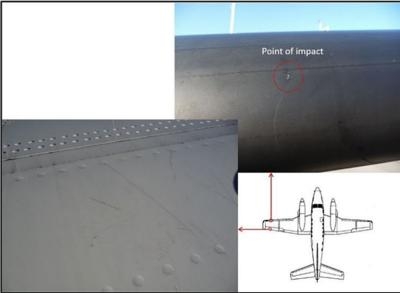Thu, Feb 22, 2018
Urges Transport Canada To Take Effective Measures To Protect The Traveling Public From Drones
In response to the Transportation Safety Board’s (TSB) recently released report on the October 2017 in-flight collision between a commercial passenger-carrying aircraft and a drone near Quebec’s Jean-Lesage International Airport, the Air Line Pilots Association, Int’l (ALPA), recently sent a letter to Transport Minister Marc Garneau calling on Transport Canada to ensure that soon-to-be-released unmanned aircraft systems (UAS) regulations provide for the safety of all users of Canadian airspace.

In the letter, ALPA highlighted concerns regarding the continuing indiscriminate and dangerous operation of UAS and pointed out that the regulations proposed by Transport Canada are inadequate.
“We believe the incident and TSB report signal a need for Transport Canada to reevaluate their planned UAS regulatory framework to ensure it more adequately addresses the risks that currently exist in the airspace system. Based on our analysis of the draft regulations, the Transport Canada proposal falls short of the regulations needed to ensure safety,” said ALPA Canada Board president Capt. Dan Adamus.
In comments to Transport Canada, ALPA highlighted:
- the complexity of the regulations. In an attempt to accommodate as many types of operations as possible with the least amount of restrictions, Transport Canada created too many categories, making it difficult for non-aviators to understand what applies to them.
- medical requirements, training, licencing, and instructor qualifications fall well short of adequately preparing pilots to safely fly UAS.
- the requirement to register UAS, a significant tracking measure in the event of an incident, would not apply to a large percentage of UAS.
- RPAS will be permitted within 1.85 km of some airports.
- all recreational users will be essentially be self-regulated for the foreseeable future, and yet this segment is perhaps the largest in number and is causing the most problems.
ALPA says that inadequate regulations for UAS also exist in the United States, as highlighted by a recent incident near Las Vegas in which a RPAS recorded a commercial jet passing under it. This prompted ALPA, along with several other aviation Associations, to appeal to Congress for more effective measures.
“As Transport Canada finalizes the UAS regulations, ALPA urges them to incorporate our recommendations. The regulations as proposed will simply not be adequate,” ALPA stated in its letter.
(Source: ALPA news release. Transport Canada image of damage from file)
More News
Touchdown Zone Lighting Two rows of transverse light bars located symmetrically about the runway centerline normally at 100 foot intervals. The basic system extends 3,000 feet alon>[...]
“Discovery and innovation are central to our mission at Virgin Galactic. We’re excited to build on our successful record of facilitating scientific experiments in subor>[...]
"We are reaching out to you today on behalf of the Popular Rotorcraft Association because we need your help. We are dangerously close to losing a critical resource that if lost, wi>[...]
UAS Traffic Management (UTM) The unmanned aircraft traffic management ecosystem that will allow multiple low altitude BVLOS operations and which is separate from, but complementary>[...]
Aero Linx: Society of Aviation and Flight Educators (SAFE) SAFE is a member-oriented organization of aviation educators fostering professionalism and excellence in aviation through>[...]
 ANN's Daily Aero-Term (05.02.24): Touchdown Zone Lighting
ANN's Daily Aero-Term (05.02.24): Touchdown Zone Lighting Aero-News: Quote of the Day (05.02.24)
Aero-News: Quote of the Day (05.02.24) Aero-News: Quote of the Day (05.03.24)
Aero-News: Quote of the Day (05.03.24) ANN's Daily Aero-Term (05.03.24): UAS Traffic Management (UTM)
ANN's Daily Aero-Term (05.03.24): UAS Traffic Management (UTM) ANN's Daily Aero-Linx (05.03.24)
ANN's Daily Aero-Linx (05.03.24)



